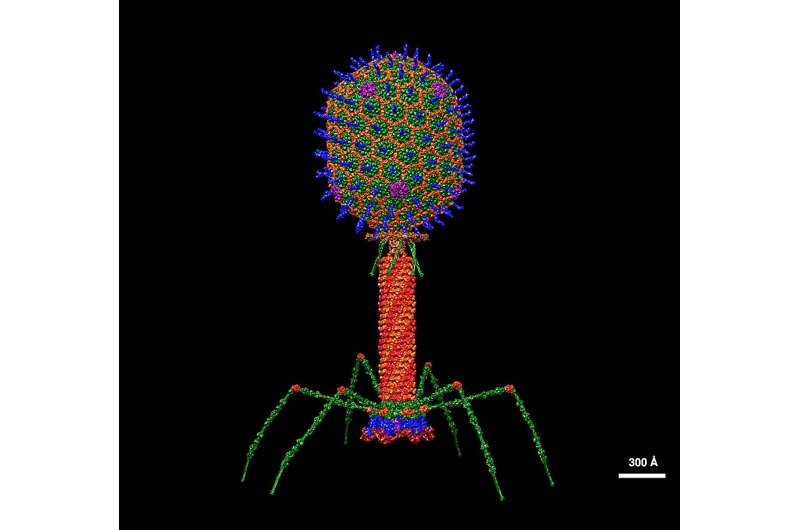June 15, 2024 report
This article has been reviewed according to Science X's editorial process and policies. Editors have highlighted the following attributes while ensuring the content's credibility:
fact-checked
trusted source
proofread
Saturday Citations: Bacterial warfare, a self-programming language model, passive cooling in the big city

There's a lot of science news in seven days, so just because a new study isn't cited here on Saturday morning doesn't mean it didn't happen. A lot more has happened. But also, check out these four stories:
Bacteria use phages as weapons
In agricultural settings on cultivated land, one variant of the bacteria Pseudomonas viridiflava will spread and become the dominant microbe, but it doesn't happen on uncultivated land. Researchers at the University of Utah wanted to figure out why, but early in their study, they observed something so unexpectedly weird that it reoriented the whole focus of the study.
While studying the genomes of bacterial pathogens, they found that one specimen had captured a phage—a virus that attacks bacteria—and repurposed it to kill off its own bacterial competitors. Specifically, the bacteria acquired non-self-replicating clusters of the repurposed phage called tailocins, which penetrate the outer membranes of pathogens and kill them.
Speculating about the finding, lead author Talia Backman says that tailocins could potentially lead to new antibiotics to address the antimicrobial resistance crisis: "While tailocins have been found previously in other bacterial genomes and have been studied in lab settings, their impact and evolution in wild bacterial populations was not known. The fact that we found that these wild plant pathogens all have tailocins and these tailocins are evolving to kill neighboring bacteria shows how significant they may be in nature."
Language model programs itself to make sense
Large language models are capable of producing text. I was going to complete this thought with "that is convincingly cogent" or something, but I had to stop and put my head down on the table because the AI hype cycle has broken its tether and become completely unmoored from reality and I'm tired.
Existing LLMs are nothing but text predictors without any knowledge of semantics or logic, and can therefore assist humans only with text generation that contains zero percent symbolic reasoning, and now they're going to be in every device. Okay, I'm not here to complain about AI hype.
In an effort to improve the performance of LLMs, researchers at MIT have proposed an innovative technique to perform natural language, mathematics and data analysis tasks by generating Python code. They call the approach natural language embedded programs, and report 90% accuracy on a wide range of reasoning tasks.
The technique is a four-step process. In the first step, the NLEP calls the packages required to perform a task. In the second step, it imports natural language representations of the knowledge or data the task requires. In the third step, the model generates a function that calculates the answer. And in step four, the model generates the result in natural language. It is also more efficient for certain tasks, particularly those in which a user has many similar questions; instead of generating a new Python program for every query, the NLEP can generate one core program and change the variables for each query.
Shirt cool
As summer heat domes settle over regions across the northern hemisphere, researchers at the UChicago Pritzker school of Molecular Engineering are reporting a new wearable fabric that can protect city dwellers in the specific conditions of urban heat islands. Existing cooling fabrics work by dispersing direct sunlight. But solar light is visible while the thermal radiation of building materials, pavement and infrastructure is infrared.
The engineers sought to create a textile with two optical properties that could reflect both sources. And since it works passively, it may have cooling applications in areas with increasing energy consumption. Beyond heat-reflecting clothing, the material has potential as a construction material to reduce interior temperatures, or as an insulator for cars. The researchers also suggest it could be used for transporting perishable foods, reducing the demand for active refrigeration systems.
Children immature, study finds
Researchers at the National University of Singapore report that a lower ratio of neural excitation (E) to neural inhibition (I) is a positive sign of brain maturation, finding that children with a lower E/I ratio perform better in school and on cognitive tests. Previous studies have found that too much excitation or inhibition carries a higher risk of brain disorders including autism, Alzheimer's disease and others. The study explored how E/I changes in youth by analyzing MRI brain scans and cognitive test scores of 885 children, adolescents and young adults.
Notably, the team created a noninvasive technique for studying neural excitation and inhibition responses. In the first part of the experiment, subjects ingested the anti-anxiety medication Xanax or a placebo before MRI brain scans—this allowed the researchers to establish that Xanax increases neural inhibition so that the overall E/I ratio decreases. In the second part of the experiment, the team established the link between E/I ratio and cognitive function by administering cognitive tests. Participants with lower E/I outperformed those with higher ratios.
© 2024 Science X Network





















